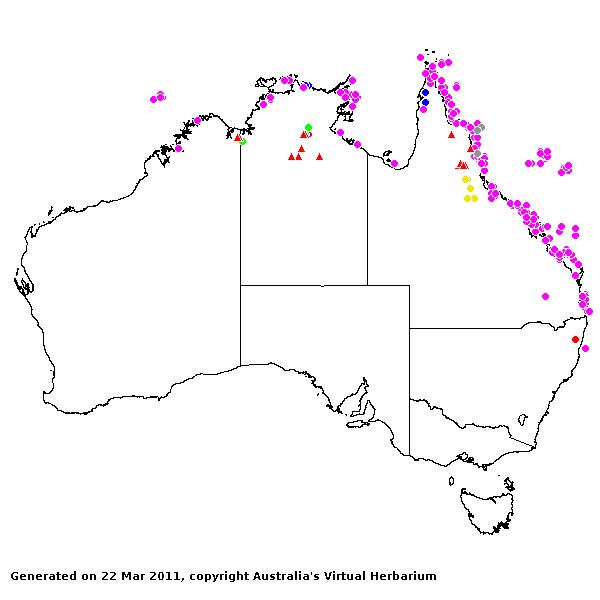Lepturus Prodr. 207 (1810).
Derivation:.
From Greek leptos (slender) and oura (tail), alluding to the
spikelet axis being produced into a point.
Taxonomic
revisions, nomenclatural references:. C.E.Hubbard, Hookers Icones
Plantarum 33. t.3261: 1–10 (1934).
Key references
(keys and floras):. G.Bentham, Flora Australiensis 7: 667–669
(1878); E.E.Henty, Manual Grasses New Guinea 121 (1969);
M.Lazarides, Tropical Grasses S.E. Asia 180 (1980); J.C.Tothill and
J.B.Hacker, Grasses of Southern Queensland 298–299 (1983); M.Lazarides
and J.Palmer, Flora of the Kimberley Region 1186, 1188 (1992);
B.K.Simon, Key to Australian Grasses 129 (1993); E.Edgar and H.E.Connor,
Flora of New Zealand 5: 519–521 (2000); D.Sharp and B.K.Simon, AusGrass
(2002); K.Mallet (ed.), Flora of Australia 44B: Poaceae 3:
418–422 (2005); S.W.L.Jacobs, R.D.B.Whalley & D.J.B.Wheeler, Grasses of
New South Wales, 4th ed, 295 (2008).
W.D.Clayton &
S.A.Renvoize, Genera Graminum (1986), genus (385).
Native. 10 species,
from coastal east Africa, Madagascar, to Australia andPolynesia. 5 species in
Australia, WA, NT, and Qld. Also New Guinea, Malesia and New Zealand.
Habit.
Perennial, stoloniferous and tufted. Leaf blades narrow. Ligule an unfringed membrane.
Inflorescence.
Inflorescence a single spike (almost cylindrical, the joints striate), a single
raceme or spike. Spikelet-bearing axes with spikelets in pairs, one sessile,
the other pedicelled, disarticulating at joints. Internodes disarticulating
transversely or disarticulating obliquely, glabrous.
Spikelets.
Spikelets all partially embedded in rachis (broadside to axis), dorsally
compressed, 2 flowered, with 1 fertile floret or with 2 or more fertile
florets, solitary, sessile; with naked rachilla extension. Fertile spikelets
adaxial (with lower glume against rachis), falling with glumes.
Glumes. Glumes
one per spikelet (the lower usually missing) or two, unequal, (the upper) long
relative to adjacent lemmas, pointed, awnless or awned (the upper glume
sometimes tapered into a short awn), dissimilar (the lower, if present, reduced
to a minute triangular scale, the upper exceeding the spikelet, thickened, with
rows of minute bristles on the back). Lower glume 1 nerved. Upper glume 5–12
nerved.
Florets.
Fertile florets 1–2. Lemmas less firm than glumes (membranous), not becoming
indurated, entire at apex, pointed, muticous, 3 nerved, hairy (minutely so, at
the base) or glabrous (glabrous). Palea relatively long, 2 nerved. Lodicules 2.
Stamens 3. Grain ellipsoid, compressed dorsiventrally. Hilum short. Embryo
large.
Kranz Anatomy.
C4.
2n = 14,
18, 26, 36, 52, and 54.
Habitat.
Xerophytic. Sandy beaches and coastal hinterland, usually good sandbinders.
Species of open habitats.
Classification.
Chloridoideae; Cynodonteae.
Notes. A
uniform genus whose taxonomy is complicated by the variability of L. repens,
leading to wide difference in the number of species accepted (Clayton and
Renvoize, 1986).
Types Species. L.
repens (Forst.) R.Br.
Biogeographic
Element. Clifford & Simon 1981, Simon & Jacobs 1990: Old World
Tropics.


